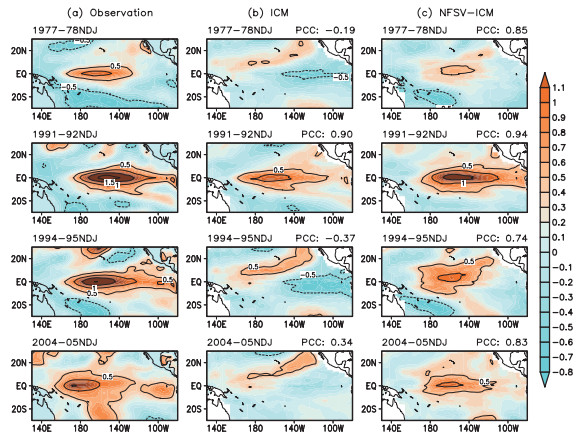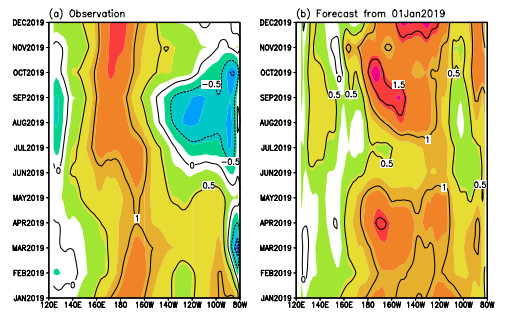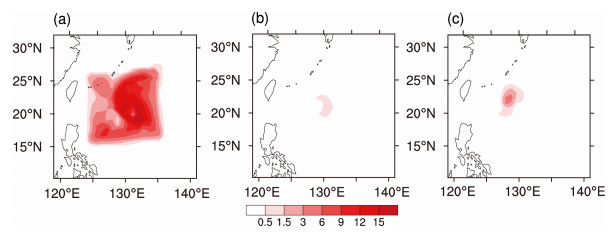| Citation: | Wansuo Duan, Rong Feng, Lichao Yang, Lin Jiang. A NEW APPROACH TO DATA ASSIMILATION FOR NUMERICAL WEATHER FORECASTING AND CLIMATE PREDICTION[J]. Journal of Applied Analysis & Computation, 2022, 12(3): 1007-1021. doi: 10.11948/20220098 |
A NEW APPROACH TO DATA ASSIMILATION FOR NUMERICAL WEATHER FORECASTING AND CLIMATE PREDICTION
-
Abstract
Based on the review of nonlinear forcing singular vector (NFSV) for dealing with the most disturbing model error and the optimal forcing vector (OFV) for neutralizing model error effect, the NFSV-data assimilation (NFSV-DA) approach was reinterpreted as neutralizing combined effect of model errors and initial errors in predictions. Then the calculation of adjoint-related gradient was derived for solving the NFSV-DA. With the applications to El Ni?o and tropical cyclone predictabilities, the usefulness of the NFSV-DA was emphasized for improving prediction skill of weather and climate. Furthermore, how to further consummate the NFSV-DA was discussed and future works were prospected. It is finally expected that the NFSV-DA becomes operational and greatly increases the prediction level of weather and climate.
-
Keywords:
- Data assimilation /
- optimization problem /
- prediction error /
- predictability
-

-
References
[1] K. Ashok, S. Behera, S. Rao et al., El Niño Modoki and its possible teleconnection, J. Geophys. Res. Ocean, 2007, 112, C11007. doi: 10.1029/2006JC003798 [2] A. Barnston, M. Tippett, M. L'Heureux et al., Skill of real-time seasonal ENSO model predictions during 2002-11: Is our capability increasing?, Bulletin of the American Meteorological Society, 2012, 93(5), 48. doi: 10.1175/BAMS-D-11-00111.2 [3] P. Bauer, A. Thorpe and G. Brunet, The quiet revolution of numerical weather prediction, Nature, 2015, 525, 47-55. doi: 10.1038/nature14956 [4] K. Bhatia, D. Nolan, A. Schumacher and M. DeMaria, Improving tropical cyclone intensity forecasts with PRIME, Weather and Forecasting, 2017, 32, 1353-1377. doi: 10.1175/WAF-D-17-0009.1 [5] M. Demaria, C. Sampson, J. Knaff and coauthors., Is tropical cyclone intensity guidance improving?, Bull. Amer. Meteorol. Soc., 2014, 95, 387-398. [6] W. Duan, C. Huang and H. Xu, Nonlinearity modulating intensities and spatial structures of Central Pacific- and Eastern Pacific-El Niño events, Adv. Atmos. Sci., 2017, 34, 737-756. doi: 10.1007/s00376-017-6148-9 [7] W. Duan, X. Li and B. Tian, Towards optimal observational array for dealing with challenges of El Niño-Southern Oscillation predictions due to diversities of El Niño, Clim. Dynam., 2018, 51, 3351-3368. doi: 10.1007/s00382-018-4082-x [8] W. Duan and X. Qin, Nonlinear optimal perturbations and its applications to the studies of tropical cyclone target observations and associated with field campaigns (in Chinese), Advances in Earth Sciences, 2022, Accepted. [9] W. Duan, B. Tian, and H. Xu, Simulations of two types of El Niño events by an optimal forcing vector approach, Clim. Dynam., 2014, 43, 1677-1692. doi: 10.1007/s00382-013-1993-4 [10] W. Duan and C. Wei, The spring predictability barrier for El Niño events and its possible mechanism results from a fully coupled model, Inter. J. Climatology, 2012, 33, 1280-1292. [11] W. Duan and P. Zhao, Revealing the most disturbing tendency error of Zebiak-Cane model associated with El Niño predictions by nonlinear forcing singular vector approach, Clim. Dynam., 2014, 44, 2351-2367. [12] W. Duan and F. Zhou, Non-linear forcing singular vector of a two-dimensional quasi-geostrophic model, Tellus A, 2013, 65, 18452. doi: 10.3402/tellusa.v65i0.18452 [13] K. Emanuel and F. Zhang, On the predictability and error sources of tropical cyclone intensity forecasts, J. Atmos. Sci., 2016, 73, 3739-3747. doi: 10.1175/JAS-D-16-0100.1 [14] F. Feng and W. Duan, The role of constant optimal forcing in correcting forecast model, Sciences in China (D), 2013, 56, 434-443. doi: 10.1007/s11430-012-4568-z [15] B. Green and F. Zhang, Impacts of air-sea flux parameterizations on the intensity and structure of tropical cyclones, Mon. Wea. Rev., 2013, 141, 2303-2324. [16] J. Hu and W. Duan, Relationship between optimal precursory disturbances and optimally growing initial errors associated with ENSO events : Implications to target observations for ENSO prediction, J. Geophys. Res. Ocean, 2016, 121, 011386. [17] H. Jeong, D. Lee, K. Ashok and coauthors, Assessment of the APCC coupled MME suite in predicting the distinctive climate impacts of two favors of ENSO during boreal winter, Clim. Dynam., 2012, 39, 475-493. [18] E. Kalney, Atmospheric Modeling, Data Assimilation, and Predictability, Cambridge University Press, Cambridge, UK, 2003. [19] B. Kirtman, S. Power, J. Adedoyin et al., Climate Change 2013: The Physical Science Basis. Contribution of Working Group I to the Fifth Assessment Report of the Intergovernmental Panel on Climate Change, Cambridge University Press, Cambridge, UK, 2013. [20] R. Lee, C. Tam, S. Sohn and J. Ahn, Predictability of two types of El Niño and their climate impacts in boreal spring to summer in coupled models, Clim. Dynam., 2018, 51, 4555-4571. doi: 10.1007/s00382-017-4039-5 [21] M. L'Heureux, K. Takahashi, A. Watkins et al., Observing and predicting the 2015-16 El Nino, Bulletin of the American Meteorological Society, 2017, 98(7), 1363-1382. doi: 10.1175/BAMS-D-16-0009.1 [22] C. Liu and J. Nocedal, On the limited memory method for large scale optimization, Mathematical Programming B, 1989, 45, 503-528. doi: 10.1007/BF01589116 [23] E. Lorenz, Predictability of weather and climate, Cambridge University Press, Cambridge, UK, 1996. [24] E. Lorenz and K. Emanuel, Optimal sites for supplementary weather observations: Simulation with a small model, J. Atmos. Sci., 1998, 55, 399-414. doi: 10.1175/1520-0469(1998)055<0399:OSFSWO>2.0.CO;2 [25] A. Moore and R. Kleeman, The dynamics of error growth and predictability in a coupled model of ENSO, Q. J. R. Meteorol. Soc., 1996, 122, 1405-1446. doi: 10.1002/qj.49712253409 [26] M. Mu, W. Duan, D. Chen et al., Target observations for improving initialization of high-impact ocean-atmospheric environmental events forecasting, Natl. Sci. Rev., 2015, 2, 226-236. doi: 10.1093/nsr/nwv021 [27] M. Mu, W. Duan and J. Chou, Recent advances in predictability studies in China (1999–2002), Adv. Atmos. Sci., 2004, 21, 437-443. doi: 10.1007/BF02915570 [28] T. Palmer, Predicting uncertainty in forecasts of weather and climate, Rep. Prog. Phys., 2000, 63, 71-116. doi: 10.1088/0034-4885/63/2/201 [29] X. Qin, W. Duan and H. Xu, Sensitivity on tendency perturbations of tropical cyclone short-range intensity forecasts generated by WRF, Adv. Atmos. Sci., 2020, 37, 291-306. doi: 10.1007/s00376-019-9187-6 [30] C. Snyder, Summary of an informal workshop on adaptive observations and FASTEX, Bull. Amer. Meteor. Soc., 1996, 77, 953-961. doi: 10.1175/1520-0477-77.5.953 [31] L. Tao and W. Duan, Using a nonlinear forcing singular vector approach to reduce model error effects in ENSO forecasting, Weather and Forecasting, 2019, 34, 1321-1342. doi: 10.1175/WAF-D-19-0050.1 [32] L. Tao, W. Duan and S. Vannitsem, Improving forecasts of El Niño diversity: a nonlinear forcing singular vector approach, Clim. Dynam., 2020, 55, 739-754. doi: 10.1007/s00382-020-05292-5 [33] B. Tian and W. Duan, Comparison of constant and time-variant optimal forcing approaches in El Niño simulations by using the Zebiak-Cane model, Adv. Atmos. Sci., 2016, 33, 685-694. doi: 10.1007/s00376-015-5174-8 [34] J. Wang, J. Chen, J. Du and coauthors, Sensitivity of ensemble forecast verification to model bias, Mon. Wea. Rev., 2018, 146, 781-796. [35] Y. Yu, W. Duan, H. Xu and M. My, Dynamics of nonlinear error growth and season-dependent predictability of el niño events in the zebiak-cane model, Q. J. R. Meteorol. Soc., 2009, 135, 2146-2160. doi: 10.1002/qj.526 [36] R. Zhang, S. Zebiak, R. Kleeman and N. Keenlyside, A new intermediate coupled model for El Niño simulation and prediction, Geophys. Res. Lett., 2003, 30, 018010. -
-
- Figure 1. The winter SST patterns of CP-El Niño in the (a) observations, (b) ICM predictions and (c) NFSV-ICM predictions, where the lead time is six months. The PCC is the spatial correlation coefficient between the observation and prediction. The NFSV-ICM, compared with the ICM, reproduced successfully CP-El Niño events of concerned much well. This figure is from [32].
- Figure 2. The observed SST anomalies from January 1st, 2019 to December 30th, 2019 and their predictions made by NFSV-ICM. (a) Observations and (b) predictions. The predictions captured the dominant mode of the observed SST anomalies, which exhibited a CP-El Niño event.
- Figure 3. The intensity forecasts of nine TCs the NFSV-DA. Red lines represent the observed TC intensities measured by the minimum SLP, black lines are for the reference forecasts, and the blue lines denote the forecasts made by the NSFV-tendency assimilation, which, compared to the reference forecasts, are much close to the observation. This figure is from Duan and Qin [8].
-
Figure 4. TC rainfall (
$ > $ 0.5 mm; red color) at$ -6 $ h (a) and 0 h (b) in reference forecast, and at 6 h in the forecast made by the NFSV-DA (c) for the TC case Dujuan, respectively. The forecast made by the NFSV-DA presented the rainfall at 6 h, which did not appear in reference. This figure is from Qin et al. [29].





 DownLoad:
DownLoad:


